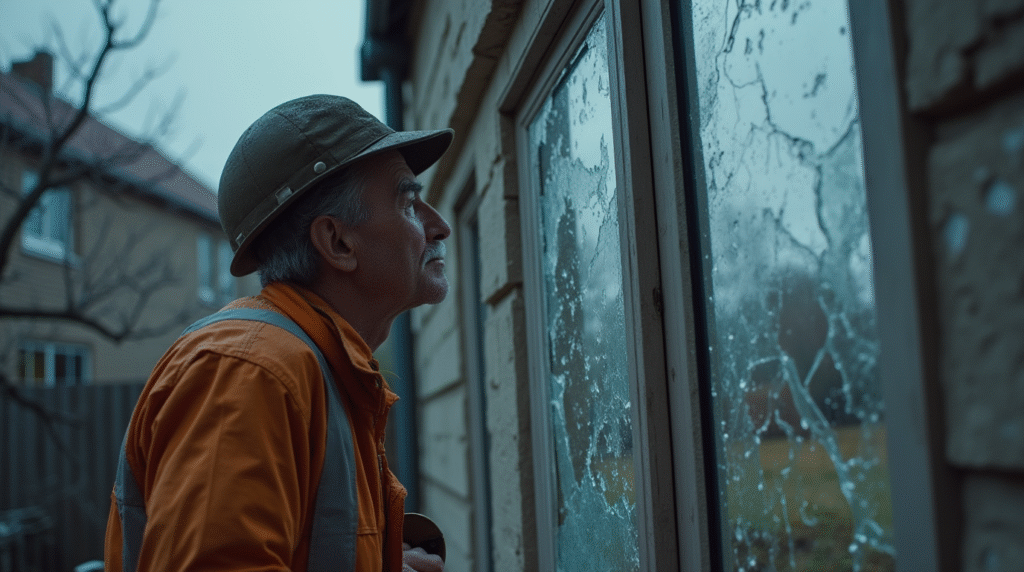
How Weather Can Shatter Your Windows (And What To Do About It)
Canadian weather packs a formidable punch.
From golf-ball-sized hail in Calgary to rapid January thaws in Toronto, extreme conditions can turn ordinary windows into dangerous projectiles.
Property owners must understand the weather forces at play and prepare both preventive and reactive strategies.
Let’s get right into it!
Weather Risks That Crack Or Break Glass
Hail Impact And Flying Debris
Hailstones reach speeds above one hundred kilometres per hour, transferring immense kinetic energy upon impact. Insurance industry figures reveal that hailstorms caused more than one billion dollars in insured damage nationwide in 2024 alone. Even tempered glass can fail when struck repeatedly, sending shards inward.
Rapid Temperature Swings Causing Thermal Stress
A sudden jump from minus fifteen to plus five degrees Celsius can create temperature differentials across the glass surface. The inner pane lags behind the warming outer pane, generating tensile stress that leads to edge cracking. Studies from the National Research Council of Canada show thermal cracks account for roughly twenty per cent of all double-pane failures in cold regions.
High-Velocity Wind Pressure Differentials
Wind gusts above one hundred and twenty kilometres per hour create suction on leeward façades. If interior air pressure remains high, windows may implode. Engineering guidelines require commercial units to withstand specific loads, yet aging seals and loose frames weaken resistance.
Ice Accumulation Expanding Existing Micro-Cracks
Freeze-thaw cycles force water into microscopic fissures. When that water freezes, it expands by approximately nine per cent, prying cracks wider each cycle. Over multiple winters, a hairline flaw can evolve into a structural fracture.
Assessing Damage After Weather Events

Conducting A Safe, Systematic Inspection
Wait until wind and lightning hazards pass before approaching damaged areas. Wear safety goggles and sturdy gloves, then check for loose shards overhead. Document every crack and hole with timestamped photos—they support insurance claims and guide repair crews.
When To Call A Professional Glazier
Contact a glazier immediately if cracks run the full length of a pane, if double-pane units fog between layers, or if broken glass threatens indoor assets. Professional assessment ensures you replace glass to code and restore thermal performance.
Documenting Damage For Insurance Claims
Insurers require proof of the weather event and resulting harm. Capture exterior footage showing hailstones or debris, record meteorological alerts from Environment Canada, and list damaged furnishings. Timely, detailed documentation speeds claim settlements, which averaged eighteen days for weather-related glass claims in 2024.
Determining Structural Versus Cosmetic Cracks
Use a straight-edge ruler to gauge crack depth. Surface scratches may only need polishing, while penetrating fractures compromise pane integrity. Structural breaks pose safety hazards and increase heating costs by up to twenty-five per cent until fixed.
Protective Upgrades And Mitigation
Laminated And Tempered Glazing Solutions
Laminated glass sandwiches a resilient polyvinyl film between panes, holding shards in place. Tempered units undergo rapid heat treatment, boosting surface compression fourfold. Both options outperform standard float glass, but laminated glass also blocks ninety-nine per cent of ultraviolet rays, protecting interior finishes.
Storm Shutters And Exterior Films
Aluminium roll-down shutters block hail and wind-borne debris. When shutters prove impractical, apply exterior-grade security film. Research from the University of Waterloo found that four-hundred-micron film reduces shatter radius by sixty per cent during impact tests.
Smart Sensors That Detect Stress In Real Time
Install wireless stress sensors along window frames. These devices relay strain data to a mobile dashboard, alerting you when loads approach critical thresholds. Early warnings enable staff to evacuate or reinforce vulnerable zones before failure occurs.
Routine Maintenance Schedules For Seals And Frames
Inspect caulking, glazing beads, and drainage holes every spring. Replace cracked seals immediately—ineffective gaskets admit water that promotes rot and weakens structural mullions. Well-maintained frames can double the lifespan of even mid-grade glazing.
Conclusion
Canadian weather remains unpredictable, but shattered windows need not be inevitable. By recognising environmental threats, assessing damage methodically, and investing in modern protective solutions, property owners can keep occupants safe and maintain structural integrity even when storms unleash their full force.
FAQs
Does homeowner’s insurance cover weather-related window breakage?
Standard policies usually cover storm damage, but deductibles and exclusions vary by insurer.
How can I tell if a crack is caused by thermal stress?
Thermal cracks often start at an edge and run straight or slightly curved across the pane after rapid temperature changes.
Are triple-pane windows more resistant to hail?
Yes, the additional layer improves rigidity and disperses impact energy, reducing break probability.
Will security film stop a window from shattering?
The film holds fragments together after impact, limiting blow-out, yet the pane may still crack.
Should I remove shattered glass myself after a storm?
You can clear small shards with proper gloves, but large or overhead pieces require a professional.
Can tree pruning prevent window damage?
Removing branches close to the façade decreases the chance of impact during windstorms.
How much do laminated upgrades cost over standard glass?
Expect a fifteen per cent premium, although energy savings and reduced insurance premiums offset the difference over time.
When is replacement better than repair?
If cracks penetrate both panes of an insulated unit, or if the seal fails and moisture appears, replacement offers lasting performance.
Does dark tint make thermal stress worse?
Very dark tints absorb more heat, raising surface temperatures; reflective low-emissivity coatings moderate this effect.
What emergency measures keep rain out after breakage?
Tape exterior-grade polyethylene sheeting over the opening and secure edges with pressure-sensitive tape until a board-up arrives.
If you have any questions about our article, How Weather Can Shatter Your Windows (And What To Do About It) or need glass repair and replacement services, contact us at 647-526-5638 or connect with us on social media.


